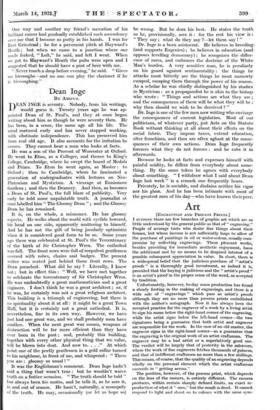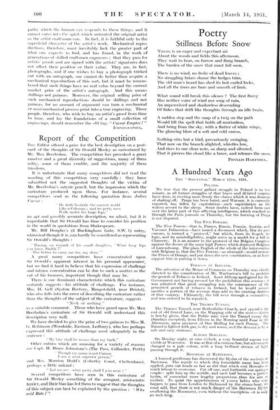Art
fENGRAVINGS AND PROCESS PRINTS.] I SUPPOSE there are few branches of graphic art which are so little understood by the general public as that of " engraving." People of average taste who desire fine things about their houses, but whose income is not sufficiently large to allow of the purchase of paintings in oil or water-colour, usually com- promise by collecting engravings. These pleasant works, besides providing for immediate aesthetic enjoyment, have the additional and by no means to be despised interest of a possible subsequent appreciation in value. In short, there is a widespread belief that the judicious purchase of " artist's proofs " is a thoroughly good investment, as indeed it is, provided that the buying is judicious and the " artist's proof " is an artist's proof in the proper sense of the word, as accepted by tradition.
Unfortunately, however, to-day mass production has found a steady footing in the making of engravings, and there is a wide sale of " engravings " which pass as artist's proofs although they are no more than process prints embellished with the author's autograph. Now it has always been the accepted practice for the engraver of a work by a living artist to sign' his name below the right-hand Corner of the engraving, while the artist signs below the left-hand corner—the two signatures being a guarantee that both artist and engraver are responsible for the work. In the case of an old master, the engraver signs in the right-hand corner—as a guarantee that the engraving is the original work of an artist craftsman The engraver may be a bad artist or a superlatively good one. The verdict will be largely that of posterity in the saleroom, where the work of fine engravers fetches thousands of guineas, and that of indifferent craftsmen no more than a few shillings. This means, of course, that the quality of an engraving depends wholly on the personal element which the artist craftsman succeeds in " getting across."
The position, however, of the process print, which depends on the lens of the camera, is entirely different. The camera produces, within certain sharply defined limits, an exact re- production of what it " sees," but the result is dead. It cannot respcind to light and shoot on to colours with the same syni- pathy which the human eve responds to these things, and it cannot enter into the spirit which animated the original artist as the artist craftsman can. In fact, it is faithful only to the superficial character of the artist's work. Mechanical repro- ductions, therefore, must inevitably lack the greater part of what one expects to find, and has found, in the work of general ions of skilled craftsmen engravers ; that they pass for artists• proofs and are signed with the artists' signatures does not affect their position or their value. They are, in fact, photographs, and if one wishes to buy a photograph tricked out with an autograph, one cannot do better than acquire a mechanical reproduction of this sort, but it must be remem- bered that such things have no real value beyond the current market price of the artist's autograph. And this means shillings not guineas. Moreover, the original selling price of such mechanical reproductions should be shillings and not guineas, for no amount of argument can turn a mechanical or semi-mechanical process print into a true engraving. Those people, therefore, who wish to buy an artist's proof from time to time, and lay the foundations of a small collection of engravings, should remember the old tag, " Caveat Emptor ! "
ICHNOGRAPHIA.
























































 Previous page
Previous page